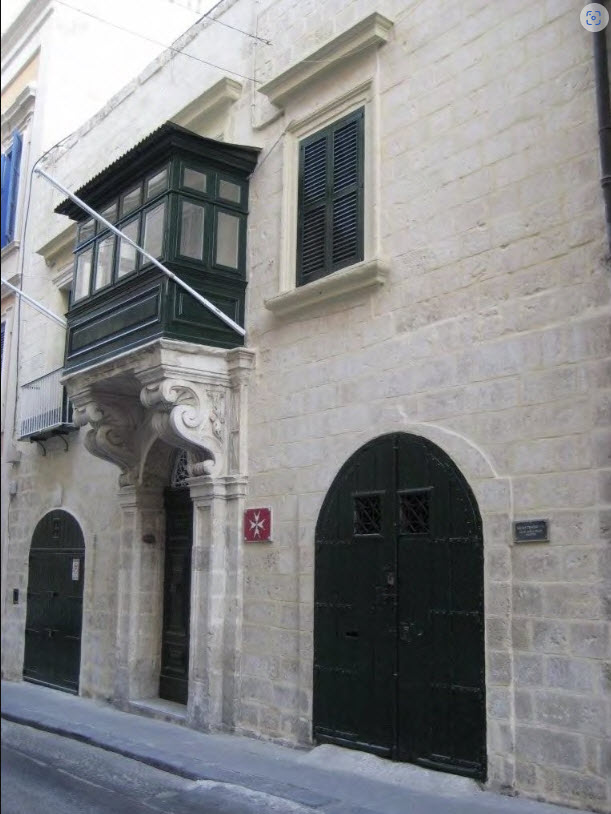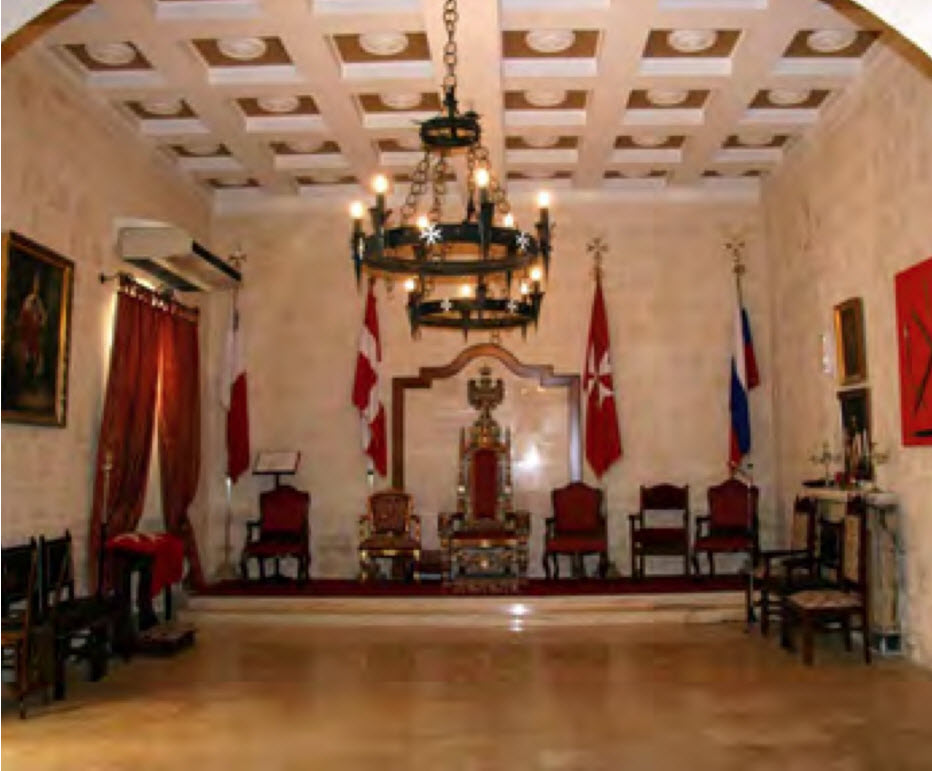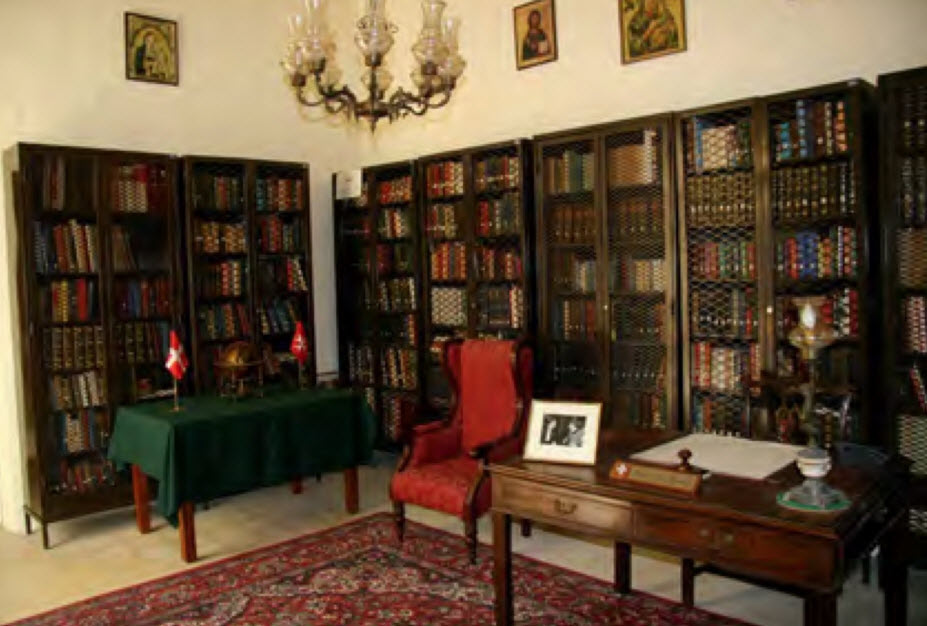by Chevalier Saviour M.Garcia KJSJ, KLJ
Situated in Malta’s capital city Valletta, directly opposite to the old Collegium Melitense (now the University of Malta Valletta Campus) stands the International Headquarters of the Order of St John of Jerusalem, Knights Hospitaller.
This beautiful two floor Baroque building ‘Palazzino Sapienti’ dates from 1629 when Fra Nicolo Sollima, then the Collegium Melitense Rector, was recorded as residing directly opposite the University’s entrance. (Entrata da Strada San Paolo). An engraving of ‘LA NVOVA CITTA E’ FORTEZZA DI MALTA CHIAMATA VALLETTA’ shows the building already standing in 1582 albeit with a thatched roof. [i]
The street dividing the Collegium from the Palazzino was constructed in a convex shape using lava stone, thus allowing rain water to pass on both sides of the street. Channels then diverted the water into wells which were dug under each and every house, flanking the street. The wells themselves were constructed in an overflowing manner, that is if one was full then the excess water passed on to the next.
Stone used for the building of the house was quarried onsite. Once the building was complete, the resultant small quarry was used as a water cistern and basement. This process of cutting stones directly from Monte Sceberras hurried the process of the building of the new city.
Palazzino Sapienti was never intended to be built higher than two floors, and this is for a reason. Had it been built higher, then it would have cast a shadow on the University sundial just opposite.
The sundial on University wall shows hour lines from 5 am to 3 pm, and is dated 13th August 1695. The Latin motto reads:
‘TEMPUS ERIT QUANDO CESSABIT TEMPUS
ERITQUE LUX AETERNA BONIS NOX SINE FINE MALIS’
meaning
‘There will be a time when time will cease
and there will be eternal light for the righteous and endless darkness for the wicked’.

The facade of the Palazzino is adorned with seashell carvings on the limestone balcony supports, in the internal court yard and on the main staircase. These symbols represent St John the Baptist, the patron saint of the Order of St.John. The seashell is also representative of the water element in this case creativity and knowledge as befits the University Rector’s house.
The main entrance has a barrel vaulted ceiling which was fashionable in the late 16th century. A staircase leads up to the piano nobile were a defaced coat of arms can still be seen.
Flanking the main entrance door one finds two gates leading to Carriage and Sedan storage place, whilst the other side was used for the horses and other beasts. The two windows on the 4 inch thick gates indicate that a minimum of 4 horses were kept there.
Barred up doors leading directly from inside the premises to both adjacent spaces are still visible. Inside these warehouses was stored wheat, straw and barley as food fodder for the animals – horses, mules, hens, rabbits, cats and dogs (beasts of burden, animals for human consumption, rat catchers, pets) wood, coal and also served as the servants’ sleeping quarters.
A servants’ service entrance was located at the back of the premises. The beast of burden conveying the goods to the ‘Palazzino Sapienti’ used to be tied to a stone hold which is still visible. Another relic from the past is the small, narrow and shallow door through which supplies were passed into the kitchen. The kitchen chimney itself is visible and likewise a rain water pipe that passes from the ceiling though the kitchen and ends on the narrow alley just where the servants entry door is located.
The presence of a carved Tudor Rose, found in the main hall (now the Throne Room) and two windows that open onto the courtyard, indicates that the original owner may have been English. Almost certainly we can refer to Knight of Malta Grand Prior of the English langue and Turcopilier Richard Shelley (b.1513-d.1589) who was an informant and trustee of the Protestant Queen Elizabeth I of England on the activities of the Jesuit Order. In return he was allowed to practice freely his Catholic religion in the English domain.
The location of the Headquarters of the Order of St John of Jerusalem, Knights Hospitaller is very significant:
1. Valletta is the capital city of Malta.
2. The street is named after Saint Paul, the Patron Saint of Malta.
3. It is one of the earliest buildings built in Valletta. Built in 1582 as the residence of the English Grand Prior Sir Richard Shelley later formed part of the Collegium complex.
4. It is half way between the Sacra Infermeria and St.Paul’s Shipwreck Church.
On 12th September 1634 a nearby gunpowder magazine blew up with the loss of 33 persons – some died immediately whilst others succumbed to their injuries days and weeks later. The devastated site was left abandoned for 30 years until Grand Master Nicholas Cottoner established the Fondazione Cottoner which rebuilt the blasted site with houses numbering from 117 to 131 in Strada San Paolo. The Palazzino had suffered some cracks in the walls and had its glass windows shattered and damaged. Some structural changes to the premises took place around this time 1664-1665.
During the Second World War the premises were used by the British Royal Air Force for the decoding of enemy aerial operations. Palazzino Sapienti survived two very near enemy bomb misses. One obliterated the court yard of the Royal University of Malta whilst another bomb destroyed and heavily damaged the buildings next to its right – buildings between St Paul Street and Archbishop Street. In 1945 King Peter II of Yugoslavia visited the Royal Yugoslavian troops stationed in Malta based on the hulk of the former S.S. Ohio of the Santa Maria convoy fame. It was during this visit that King Peter II entered for the first time in Palazzino Sapienti 223, St.Paul street, Valletta. Years later he was to establish a fund for the purchase of said premises.
Between 1945 and 1955 the building was used as a Government primary school for the Valletta children. The proper Valletta school was being rebuilt after it was destroyed by bombing during WWII. The present Government primary school in Valletta occupies the site where during the Order’s rule there was the Convent of St Magdalene.
Bought in 1973 by the Russian Grand Priory of Malta, the premises house some very interesting artifacts.
It houses the complete library and medals of the late Professor Donald Harrison Smith and the late Professor John Parr USN.
The building also boasts of three saint reliquaries:
– a first degree bone fragment from the Order’s patron saint St. John the Baptist,
– and two third degree relics: Throne chair on which St. John Paul II sat during one of his Papal visits to Italy and a hand signed dedication by Sister Mother Theresa of Calcutta who was also a member of the Order in 1981.
An excellent Chippendale desk and a multiple of other genuine antique furniture embellish the place. Paintings donated or painted by members of the Order adorn the Throne room.
All the furnishings in the premises are attributed to donations by the following members of the O.S.J.:
Bailiff Dr.Victor Captur M.D., B.Sc., F.A.C.C., O.S.J (furniture)
Bailiff Carol.L.Marguerat OSJ, G.C.S.C (swords, silverware etc)
Bailiff Emeritus Albert Delia OSJ (furniture and pictures)
Grand Cross of Justice Nicola Di Filippo (paintings)
Others contributed by giving cash donations whilst others give their time.


Notable Tenants of the Palazzino Sapienti
Various notable tenants resided at the Palazzino Sapienti
Fra Nicolo Sollima was a member of the Order of St.John and a Dominican monk. It is extremely interesting to find a Dominican Rector in charge of the Jesuit’s Collegium Melitense (the forerunner of the University of Malta). This could explain why Fra Sollima was residing outside the Jesuit Convent. Being a Dominican he was certainly very close to the Papal Inquisitor in Malta Nicolo Herrera (1627-1630) if not imposed by the Inquisitor himself on the Jesuit Order. It should also be borne in mind that initially St. Paul’s Shipwreck Church was intended to be built on the site were the University of Malta Valletta Campus now stands.
Capitano Antonio Garzin was active in Valletta between 1626 and 1650. He was involved in the building of Luqa St Andrew’s Parish Church in 1626 and in 1630 designed the Dominican Priory at Rabat. Capitano A. Garzin lived in at least 3 different addresses in Valletta amongst which is Palazzino Sapienti Strada San Paolo, 223 [1]. It is almost certain that Capitano Antonio Garzin got acquainted with Fra Nicolo Sollima around this time and was assigned the Dominican Priory project in Rabat upon a recommendation by Fra Nicolo Sollima.
Mgr Onorato Bres who in 1812 spoke on behalf of the rights of the Maltese with the recently established British administration. Commander of the Order of St.John, Apostolic delegate and head of the Pontifical province of Frisinone (1821) He was also author of various books. [v & vi].
Professor John Austin (1790-1859) from the University of London resided at the place in August 1836 whilst conducting the first British colonial census held in Malta. Proffessor Austin was also a Royal Commissioner [viii]
Giuseppe Ceccato from Verona, Italy worked for the Manoel Theatre as sceneographer on 20th December 1854 and from a receipt of his salary it transpires that he was residing at 223, Strada San Paolo, Valletta. [iii]
Michelangelo Degiorgio LL.D. was residing at the premises between 1860 and 1900 – as per voting documents.[ii]
Luigi Camilleri LL.D (1892-1989) (later Chief Justice, Sir) was in 1920 the tenant at 223 Strada San Paolo as per voting documents.[ii] Saturday afternoon of the 7th June, 1919 found Prince Lobanov-Rostovsky and Count Andrey Bobrinsky both Russian Imperial refugees visiting their friend Dr. Luigi Camilleri at his residence in Valletta, when the ‘Sette Guigno’ riots broke out. A large crowd made its way to the Royal Malta University situated exactly opposite Dr. Luigi Camilleri’s residence and attacked same. The English Imperial flag was torn down from the Royal Malta University building. These two Russian nobles were scared stiff since the remembrance of the Bolshevik revolution still haunted them. They stayed at the premises till the 12th June when they were escorted back to San Anton Palace in Balzan by Police Superintendent James Frendo Cumbo. Prince Lobanov-Rostovsky and Count Andrey Bobrinsky were both Hereditary Commanders of the Order of St. John in Russia.[iv and ix]
____________
Notes:
1. Door numbers were introduced during the 17th Century and made compulsory in Malta during the British Colonial period 1800 to 1964. During the reign of Malta by the Order of St John (1530-1798) important buildings were known by names (e.g. Casa Rocca Piccola, Palazzo Messina etc)
Palaces, Theatres, Gardens, Auberges, Prisons, Hospitals and Churches were constructed by the Knights of Saint John. Commoners employed in Valletta as cooks, cleaners, washers, horse drivers, carriers etc, lived in rooms reserved for the servants when employed by members of the Order, the Catholic Church or the Nobility.
2. Sir Luigi Camilleri, Kt. Bach (b.1892-d.1989) was a Politician, Magistrate, Judge and Chief-Justice.
Sir Luigi Camilleri, was a distinguished son of Gozo, who lived up to nearly a hundred years. He lived in eventful years, Luigi Camilleri was a child prodigy who matriculated at thirteen years and graduated at twenty. At twenty-eight he was one of the pioneer members of the Malta Legislative Assembly under the 1921 Self-Government Constitution, having been elected on the first count as one of the four members of the Partito Democratico Nazionalista for Gozo, where he had established a very successful legal practice. He was appointed Magistrate and later Judge, for twenty-two years, which included the turmoil of World War II and the equally turbulent pre-war and post-war years. He was a central figure in the Ultra Vires and the Internees cases and in the Conspiracy Trials. Maltese nationals were accused of treason by the British authorities. He was Chief Justice for the last five years of his career during which time he was Knighted. Thirty-four years as a member of the Judiciary is probably a local record.
3. Mgr Onorato Bres (b.1753-d.1818) wrote 2 books ‘Recherches Historiques et Politiques sur malte. Ornes de gravures repsentant les medailles antiques et de la carte de cette Isle’ (Paris an VII,1799) and ‘Malta Antica Illustrata co’documenti e coll’istoria (Roma 1816). Mons Bres was a Conventual Chaplain of the Order of St John. He was appointed as member of various Italian Academies, in Viterbo (Italy) made an Apostolic Delegate and got the title Monsigneur. He passed away after contracting a terminal illness in this city on 12th November, 1818 aged 65years
________
References:
[i] National Library of Malta (Matteo Perez d’Allecio 1582),
[ii] Government Gazette of 1860, 1870, 1880, 1900 and 1920 held at Santu Spirtu, Rabat, Malta.
[iii] Manuel Theatre archives held at Santu Spirtu, Rabat, Malta.
[iv] Malta Police Museum, Floriana, Malta.
[v.] Letter written by Onorato Bres to Lt.General Hildebrand Oakes National Library of Malta, 385)
[vi.] L’Arte,Vol-III,n.57 (1865) by R.Barbaro. ‘Notizie di alcuni cavalieri Del S.O.Gerosolimitano illustri per lettere e per belle arti p.67 (Napoli 1841)
[vii.] ‘Sir Luigi Camilleri, His life and Times’ by Andre’ Zammit
[viii] Santu Spirtu archives Rabat, Malta
[ix] President of Malta Profs. Guido De Marco personal documents.
